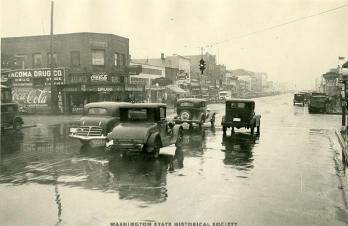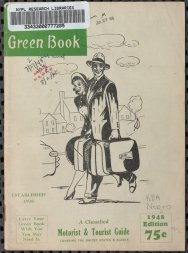In 1940 a former traveling salesman named Duncan Hines published the third edition of his book, Lodging for a Night, a catalog of roadside motels and eateries that he and his  wife Florence felt were worth pulling over for. The state by state guide book came before an interstate highway system and organized it’s recommendation by city and town. Duncan and Flo went on to build the guidebook idea into a popular syndicated newspaper business and then a recipe and food brand that made them millionaires.
wife Florence felt were worth pulling over for. The state by state guide book came before an interstate highway system and organized it’s recommendation by city and town. Duncan and Flo went on to build the guidebook idea into a popular syndicated newspaper business and then a recipe and food brand that made them millionaires.
But back in the days when they were on the road, the Hines’ could make or break a roadside motel or diner. They were the Michelin Guide star system of America’s highways before the Second World War and the Interstate freeways to follow .
.
Flipping through the 1940 edition of Lodging to the chapter on Washington State and Tacoma the listings include the first class Tacoma Hotel downtown and three motor courts on Highway 99; Dittemore’s at 12701 Pacific Highway, Tahoma Motor Court at 3836 South Tacoma Way (formerly one of Tacoma’s first roadside auto camps built in 1924) and the Waltoma at 9200 South Tacoma Way.
The Hines’ were particularly taken with Walt and Oma Kupfer’s self named 12 unit motel, built in 1938 complete with an Art Deco neon road sign, garages with each ultramodern all electric cottage and a manicured front lawn. The guide praised it as “one of the best anywhere around”. By the late 1930’s Highway 99/South Tacoma Way was becoming a heavily trafficked thoroughfare for automobiles and buses, one of the busiest sections of the state’s main North/South traveler’s route.

By summer of 1940 turn-offs to Mt. Rainier National Park and the new bridge over Tacoma Narrows to the Olympic Peninsula were nearby. The freshly paved and widened roadway between Tacoma and Fort Lewis had become lined with gas stations, markets and motels South of the intersection at 54th. The sprawling brick shops and yards of the Northern Pacific Railroad once served as an economic and physical backdrop for the busy commercial district along South Tacoma Way but the great depression, waning travel on America’s railroads and the popularity of the automobile were diminishing the workforce and the neighborhood.

Barber shops, bakeries and butcher shops were disappearing along with the streetcars that stopped running down South Tacoma Way in 1936. The era of change from rail to road cars and rubber tires was on full display at the crossing of 54th where, looking through the windshield, South Tacoma Way became Highway 99. Two lanes in each direction for Buick Roadmasters, Ford pick ups and Greyhound buses was the new normal.
It was also in 1940 that Washington State finally published its version of the New Deal American Guide Series, a federal WPA program that put writers and artists to work in each state collecting folklore, recording local history and designing maps and tours that guided tourists to parks, natural attractions, small towns and historic places. Washington, A Guide to the Evergreen State was assembled and sponsored by the Washington State Historical Society in Tacoma and it was one of the last and thickest glove-box guidebooks created to encourage highway tourism and interstate travel. Tacoma was a hub for several of the tours in the State guidebook and like the Duncan Hines book it fueled the growing traffic and roadside attractions that appeared during the 20’s, 30’s and early 40’s.
and designing maps and tours that guided tourists to parks, natural attractions, small towns and historic places. Washington, A Guide to the Evergreen State was assembled and sponsored by the Washington State Historical Society in Tacoma and it was one of the last and thickest glove-box guidebooks created to encourage highway tourism and interstate travel. Tacoma was a hub for several of the tours in the State guidebook and like the Duncan Hines book it fueled the growing traffic and roadside attractions that appeared during the 20’s, 30’s and early 40’s.
Unlike the WPA Evergreen State Guide, which was a tome at more than 600 pages, The Green Book began publishing in 1936 as a thin safe passage guide for African American  travelers before the Civil Rights era. An essential coded companion for black tourists and travelers in the South and mid west, the Green Book began covering the far west in well explored detail after World War II. Interestingly, it was one of the Highway 99 auto courts that first appeared in the guide after the war, Dittemore’s at 12701 Pacific Highway which rented cabins, served good meals and was also listed in Duncan Hines’ roadside guide.
travelers before the Civil Rights era. An essential coded companion for black tourists and travelers in the South and mid west, the Green Book began covering the far west in well explored detail after World War II. Interestingly, it was one of the Highway 99 auto courts that first appeared in the guide after the war, Dittemore’s at 12701 Pacific Highway which rented cabins, served good meals and was also listed in Duncan Hines’ roadside guide.
The era of Highway 99, gas guzzling sedans and tidy auto courts reshaped South Tacoma but the transformation lasted barely 15 years after the war. In 1959 six lane Interstate Five was completed from Ft. Lewis to the cloverleaf interchange at 72nd and soon after the entire road system shifted east. South Tacoma Way, the Pacific Highway, Old Highway 99 became lined with automobile dealerships, drive thru restaurants and drive in movie theaters. Like the age of steam and railroads that preceded it the first draft of the motor age came and went on South Tacoma Way.

An updated version of the 1940 Guide to the Evergreen State is available on line from the Washington Trust for Historic Preservation. It provides tour routes, historical background and stories and a rich unpacking of Washington’s best roads, destinations and backstories. Here’s a link:



Here’s the best comment I read, ” Interestingly, it was one of the Highway 99 auto courts that first appeared in the guide after the war, Dittemore’s at 12701 Pacific Highway which rented cabins, served good meals and was also listed in Duncan Hines’ roadside guide.” Thank you to the Dittemore family.
LikeLike
Thank you for the most interesting article.
LikeLike
I have a beautiful perfect new condition postcard of Motel Waltoma.
LikeLike